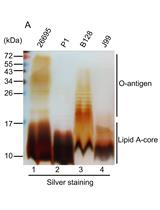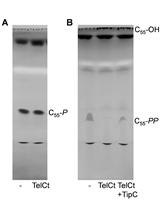- EN - English
- CN - 中文
Procedure for Rhamnolipids Quantification Using Methylene-blue
使用亚甲蓝进行鼠李糖脂量化的方法
发布: 2016年04月05日第6卷第7期 DOI: 10.21769/BioProtoc.1783 浏览次数: 16303
评审: Valentine V TrotterAlexander B. WestbyeAnonymous reviewer(s)
Abstract
Rhamnolipids produced by Pseudomonas aeruginosa (P. aeruginosa) represent a group of biosurfactants with various applications (e.g., bioremediation of oil spills, cosmetics, detergents and cleaners). The commonly used colorimetric methods for rhamnolipid quantification, including anthrone, phenol−sulfuric acid and orcinol based quantification (Helbert and Brown, 1957; Chandrasekaran and BeMiller, 1980), are laborious and operationally hazardous because of the strong acid/chemical emanation which can cause deterioration of instruments measurements (e.g., spectrophotometer). Therefore, the methylene-blue-based analysis appears as a promising alternative to safely quantify whole rhamnolipid molecules based on chemical complexation reaction (Pinzon and Ju, 2009). Indeed, methylene blue and rhamnolipids form a complex in a water-chloroform phase system. The rhamnolipids-methylene blue complex is partitioned into the chloroform phase which will develop a blue color that can be quantified at 638 nm to deduce rhamnolipids concentration. Here, we describe a variant of methylene-blue-based rhamnolipids quantification procedure that allows spectrophotometric quantification on standard 96-well plastic microplate contrarily to original methylene blue procedure that requires specific and expensive microplate due to chloroform chemical properties.
Keywords: Rhamnolipids (鼠李糖脂)Materials and Reagents
- Borate Buffer Packs BupHTM (Thermo Fisher scientific, catalog number: 28384 )
- Centrifuge round bottom reaction tubes (30 ml) (Krackeler Scientific, COREX®, catalog number: 1-8445-30 )
- Greiner CELLSTAR® 96 well plates (clear polystyrene wells flat bottom) (Sigma-Aldrich, catalog number: M3687-60 EA )
- Microcentrifuge tube [2 ml, transparent polypropylene (PP) with Lid] (Sigma-Aldrich, Brand®, catalog number: Z628034-500 EA )
- Sterile culture tube (PP) (14 ml) (The Lab Depot Inc., catalog number: TLDT8235 )
- Centrifugal Filter (0.1 µm pore size, Non-Sterile) with Durapore® PVDF Membrane UFC40VV25 Ultrafree® (2 ml) (Merck Millipore Corporation, catalog number: UFC40VV25 )
- Aluminium foil
- Micropipettor (10 µl,100 µl and 1,000 µl) tips
- Pseudomonas aeruginosa (P. aeruginosa) PAO1 Wild-type (strain PAO0001) (http://www.pseudomonas.med.ecu.edu/)
- Chloroform (≥ 99% ) (Carl Roth GmbH & Co. KG, catalog number: 3313.1 )
- Ethyl acetate (> 99.5%) (Merck Millipore Corporation, EMSURE®, catalog number: 1096231000 )
- Hydrochloric acid (HCl) standard (1 N solution) (Sigma-Aldrich, Fluka analytical, catalog number: 318949-500 ml )
- HCl standard (0.2 N solution in water) (Sigma-Aldrich, Fluka analytical, catalog number: 343102-500 ml )
- Luria Bertani (LB) Broth (Lennox) Powder microbial growth medium (Sigma-Aldrich, catalog number: L3022-250 G )
- Methylene blue solution [1.4% (w/v) in 95% ethanol] (Sigma-Aldrich, catalog number: 1808-50 ml )
- 3-(N-morpholino) propanesulfonic acid (MOPS) (99.5%) (Sigma-Aldrich, catalog number: M1254-100 G )
- Rhamnolipids (90%, Standard) (Sigma-Aldrich, catalog number: R90 )
- Sodium hydroxide (NaOH) solution
- LB-MOPS broth (see Recipes)
- Borax buffer (50 mM) (see Recipes)
- Methylene blue aqueous solution (see Recipes)
Equipment
- Micropipettor (100 µl-1,000 µl)
- Micropipettor (10 µl-100 µl)
- Autoclave
- Stopwatch
- Measuring Pipette (5 ml) (Jaytec Glass Limited, catalog number: WJ.485 )
- 96-well microplate spectrophotometer (e.g. Molecular Devices, model: SpectraMax M2 device )
- Vacuum concentrator (e.g. Savant SPEEDVAC SVC 200H: 200 x g)
- Tabletop centrifuge
- Vortex mixer
Procedure
文章信息
版权信息
© 2016 The Authors; exclusive licensee Bio-protocol LLC.
如何引用
Rasamiravaka, T., Vandeputte, O. M. and Jaziri, M. E. (2016). Procedure for Rhamnolipids Quantification Using Methylene-blue. Bio-protocol 6(7): e1783. DOI: 10.21769/BioProtoc.1783.
分类
微生物学 > 微生物生物化学 > 脂质
生物化学 > 脂质 > 胞外脂质
生物化学 > 脂质 > 脂质测定
您对这篇实验方法有问题吗?
在此处发布您的问题,我们将邀请本文作者来回答。同时,我们会将您的问题发布到Bio-protocol Exchange,以便寻求社区成员的帮助。
Share
Bluesky
X
Copy link













